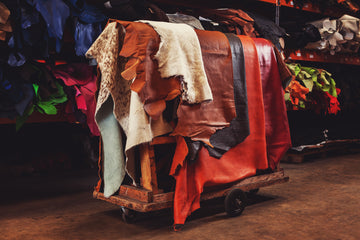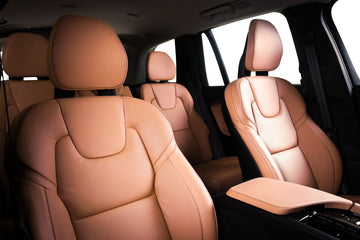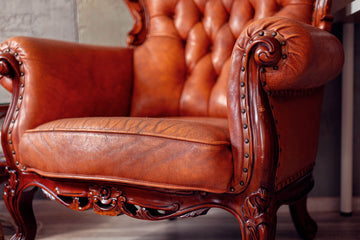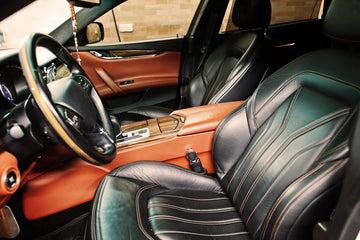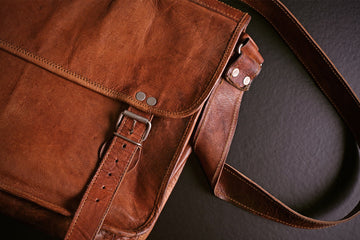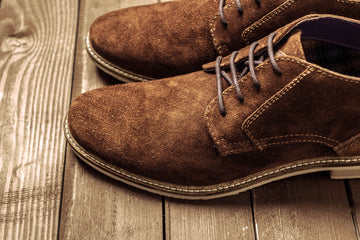Are you looking to upgrade your car's interior with the best leather for upholstery or car seats? Deciding between full-grain, top-grain, or Nappa leather involves weighing factors like durability, ease of cleaning, comfort, and cost-efficiency. Our comprehensive guide dives into the nuances of each leather type to help you make an informed choice that aligns with your lifestyle and vehicle usage.
Key Takeaways
- Full-grain leather is the highest quality type for car upholstery, offering durability and a luxurious, authentic look with natural grain and markings. Many experts prefer full-grain leather for its superior quality, though it requires regular maintenance to preserve its appearance.
- Top-grain leather balances quality and practicality. Its smoother and more uniform finish is easier to maintain than full-grain leather, making it a cost-effective option for car seats.
- Nappa leather, known for its superior softness and comfort, is often used in high-end vehicles but demands regular upkeep to maintain its luxurious quality and prevent wear.
Exploring the Premium Feel: Full-Grain Leather for Car Upholstery
The sensation of settling into a car seat covered with full-grain leather is unparalleled. This top-tier leather, renowned for its distinctive features and inherent elegance, delivers a genuine and opulent experience that elevates the interior of any vehicle to one of high status. Full-grain leather retains the original textures and blemishes from the animal's skin, making it the superior option for car upholstery.
Full-grain leather distinguishes itself by:
- Preserving its natural texture and robustness as it isn't subjected to sanding or buffing.
- Providing both visual appeal as well as enhanced endurance.
- Demonstrating an impressive ability to withstand wear over extended periods, much like tanned bovine leathers resistant to damage and suitable for covering large surfaces.
This level of premium quality certainly involves specific considerations, which will be explored in more detail in the following sections. Of course, the focus will be maintained on these critical aspects.
The Elegance of Natural Grain
Full-grain leather's charm is found within its unaltered grain. This type of leather preserves the hide's full texture and inherent markings, bestowing a genuine aura and personality upon automobile interiors. The distinctive textures and designs that emerge contribute an element of sophistication and exclusivity to vehicle cabins.
Each piece's natural flaws in full-grain leather add to its one-of-a-kind nature, endowing automobile seats with singular distinction, thus rendering every journey an intimately unique experience.
Durability Meets Luxury
Opting for full-grain leather in your car's interior enhances the visual appeal and ensures longevity. As the best leather for car seats, its inherent resilience and natural look make it ideal for luxurious vehicle upholstery. The incorporation of full-grain leather into areas within a vehicle that sees extensive use is indicative of dedication to both quality and endurance. It simultaneously improves comfort and allows better airflow compared to traditional fabric seats. Light leather seats tend to get dirty more quickly and need more maintenance.
Real leather repeatedly proves its ability to withstand wear and tear, frequently outliving the cars it furnishes while preserving its elegance despite regular exposure to various substances that could mar lesser materials. When selecting leather for car interiors—particularly seating—it's wise to choose full grain as the highest aesthetic refinement and robustness standard. This choice can enhance immediate satisfaction and contribute positively to maintaining or increasing your vehicle's value over time.
Maintenance Considerations
Maintaining full-grain leather is crucial to preserving its excellent condition. Routine cleaning, conditioning, and safeguarding measures are necessary. Though this may seem like a significant investment of time and effort, the outcome justifies the maintenance. In car interiors, ongoing attention ensures that full-grain leather retains its characteristics and has an extended lifespan.
Much like human skin care, where hydration prevents dryness and cracks, regular application of cleaners and conditioners is vital for keeping full-grain leather pliable while averting cracking as it ages. This level of upkeep is essential to maintain the tactile feel and visual appeal of leather in vehicles.
Extra caution must be exercised when getting into or out of vehicles with luxurious seats crafted from full-grain leather. Sharp objects or metal fastenings pose risks, such as scratches or tears on these surfaces. With appropriate handling and diligent care routines, you can ensure your vehicle's interior remains soft and sophisticated over many years.
Top-Grain Leather: Balancing Quality with Practicality
Top-grain leather is a compromise between the epitome of luxury, full-grain leather, and practical needs. Being second only to full-grain in quality ranking, top-grain leather is utilised where durability must meet opulence. Known for its sumptuousness while being less demanding in upkeep and providing comfort, many consider it the best leather to cover car seats and upholstery when prioritising functional elegance.
While not quite matching its superior counterpart's endurance or patina-forming ability, full-grain leather—top grain offers a polished consistency that simplifies cleaning processes. As an attractive yet more accessible alternative for vehicle interiors than the pricier full-grain variant, it still preserves an upscale appeal.
In subsequent sections below, we will explore what sets top-grain leather apart. It is the preferred material choice within auto upholstery, where sophistication is sought without sacrificing utility.
Smooth Finish and Uniform Look
Sanding and buffing are key to creating the smooth and consistent look that characterises top-grain leather, a feature particularly coveted for automotive upholstery. By eliminating natural imperfections in the hide, this treatment ensures that the leather presents an even texture and uniform aesthetic across its surface—highly prized in car interiors.
A sleek and homogeneous appearance is greatly valued in car upholstery. For this reason, top-grain automotive leather stands out as it delivers beauty akin to full-grain leather while also providing a more budget-friendly option when outfitting vehicle interiors with high-quality material.
Cost-Effective Elegance
Top-grain leather is an optimal choice for those seeking luxury and cost-effectiveness, particularly in car upholstery and seats only. It represents a mid-point between premium full-grain leather and more affordable corrected-grain leather, providing both sophistication and value. For instance, you can acquire top-grain leather for around £152.50 for 50 square feet with a thickness of approximately 1.2mm.
For covering furniture or various items with the best possible advantages of leather while maintaining affordability, top-grain stands out as an ideal solution. It allows individuals to enjoy genuine leather's sumptuous texture and upscale appearance without incurring excessive expenses.
Caring for Top-Grain Leather
While full-grain leather requires more care than top-grain, it's crucial to regularly maintain the quality of your car's top-grain leather seats. This includes:
- Routine cleaning.
- Using conditioner to maintain its looks and prevent signs of wear.
- Employing specialised products designed for protection and longevity to handle abrasions or damages.
Prioritise gentle treatment by vacuuming the genuine leather seats using a soft brush attachment before applying any cleaner—this will safeguard against scratches on the delicate surface of top-grain leather. Opt for dedicated leather-cleaning solutions over harsh soaps when treating your vehicle's interior, ensuring you can enjoy the sleekness and refinement provided by well-maintained top-grain leather seating for many drives ahead.
Nappa Leather: Softness and Sophistication in High-End Vehicles
Nappa leather is ideal for those pursuing the ultimate expression of luxury and comfort for their car's interior. Its softness is unparalleled, providing a smooth feel that elevates the comfort level within high-end cars. Full-grain leather, typically found in prestigious vehicles such as Mercedes Benz, adds a richly luxurious touch to any car's interior, including the steering wheel. Full-grain leather like aniline or semi-aniline-finished bovine Nappa is particularly recommended for car steering wheels instead of wheels due to the constant rubbing they endure.
It should be noted, though, that while Nappa leather enhances the driving experience with its superior texture and comforting embrace, maintaining this type of material requires consistent care to ensure its plush qualities remain intact over time. In subsequent sections, we'll explore the indulgent realm of Nappa leather interiors.
The Soft Touch of Luxury
Nappa leather stands out for its lavishness and comfort. Its refined grain and supple texture are distinctive, as it employs hides of younger animals such as calf or kid goat skins. Nappa leather's soft, characteristic touch is achieved through a specialised tanning process involving chromium or aluminium sulfates and salts, giving it an exceptionally smooth and flexible quality. Chrome-tanned bovine leathers like Nappa are recognised for their unique blend of sumptuousness and comfort. High-quality leather products frequently utilise chrome-tanned whole cowhides.
This fine-grained, silky-smooth type of full-grain leather is particularly sought after in automotive interiors, where it adds a sense of luxury due to its plush tactile qualities. This demonstrates why Nappa leather enjoys prominence as a material that enhances the luxurious ambience within vehicles.
Luxurious Looks That Require Love
While exuding a luxurious facade, Nappa leather demands consistent maintenance to prevent its texture from becoming compressed. To care for Nappa leather effectively, it is recommended that one use a gentle cloth for wiping and specialised cleaners designed to treat any blemishes on the interior and genuine leather itself.
Even though Nappa leather boasts substantial durability, it is susceptible to bleaching from sunlight exposure and necessitates regular attention to prevent deterioration. This continual need for upkeep often makes tanned bovine leathers—known for their resistance to similar problems—preferable in certain situations.
Is Nappa Worth the Splurge?
Despite its substantial upfront cost, investing in Nappa leather is a sound decision due to its advantageous features. The water-soluble dyes used in treating nappa leather reduce the likelihood of colour fades and simplify the cleaning process. Nappa leather is an investment worth considering for car owners who value high quality and straightforward upkeep for their vehicle's interior.
With its reputation for providing a lavish look and superior comfort as car upholstery, Nappa leather is an attractive option for individuals who want to enhance their automobiles with luxury and refinement.
Other Materials and Alternatives to Leather
Leather is often chosen for car seat upholstery, yet other materials serve as viable alternatives. These include imitation leather, Alcantara, and bonded leather—each possessing unique advantages and shortcomings to accommodate varied preferences such as budget considerations or ecological concerns.
Diving into these options more closely reveals that imitation leather—also referred to as synthetic leather or leatherette—emulates the look of real leather while being less costly and more aligned with ethical standards concerning animal welfare.
Meanwhile, Alcantara stands out due to its durability and similarity in price to genuine leather. It is frequently selected by automotive companies to cover a car steering wheel armrest head well, protecting it from rubbing and potential damage.
Lastly, bonded leather provides a cost-effective solution. This involves blending shredded pieces of actual hide using adhesives before coating them for a full leather appearance. This material not only offers affordability but also boasts simplicity in maintenance.
Imitation Leather: A Budget-Friendly Alternative
Leatherette, an imitation leather product, is often favoured by individuals seeking the appearance and texture of real leather without incurring significant expenses. It provides a budget-friendly yet chic solution for upholstering items such as furniture and car seats while being more ethical towards animals.
This faux leather alternative boasts greater ease of maintenance and improved resilience against UV exposure and cracking when contrasted with authentic leather. Despite these benefits, it is important to acknowledge that imitation leather's endurance level needs to be higher than traditional genuine leather. It might exhibit signs of wear sooner.
Alcantara: The Synthetic Cousin
Alcantara, a synthetic material similar to leather, is increasingly favoured as an option for high-end car interiors due to its similar cost and robustness. This fabric's resistance to water and stains and its lighter weight compared to real leather offer a suede-like feel that has captured automakers' attention when seeking durable materials for vehicle upholstery.
Employed extensively in luxury vehicles, Alcantara adorns various interior parts, including dashboard, steering wheel armrests, and seat covers. It also extends over headrests and console covers and is used specifically to sheathe car front seats, dashboard, steering wheel, and wheels.
Bonded Leather: When Cost is King
For individuals who place the highest importance on maintaining a budget, bonded leather is an optimal choice. As the least expensive alternative among various leather types used in car seat manufacturing, bonded leather consists of fragmented pieces of hide amalgamated with binding agents to mimic the appearance and texture of solid leather. Not only does this result in a cost-effective material, but it also boasts ease of maintenance, which is a significant advantage for vehicle upholstery.
Despite its appeal to frugality, bonded leather cannot match the enduring quality and lifespan offered by authentic leather. Consequently, even though genuine leather is initially beautiful due to its affordability, reliance on bonded leather might prove disadvantageous since it doesn't possess equal resilience or long-term viability compared to genuine materials.
How to Choose the Right Leather for Your Car Seats
With all this information about the different types of leather and their alternatives, you might wonder, "H" w do I choose the right leather for my car seats?" "All the answers depend on various factors.
When selecting a car with leather upholstery for car seats, it is essential to balance personal preferences in style and texture with practical aspects like matching the vehicle's vehicle's colour scheme. The key factors to consider when choosing leather upholstery include:
- Durability
- Comfort
- Maintenance requirements
- Aesthetic appeal
- Overall cost.
It's like choosing the perfect outfit—much depends on personal taste and lifestyle. Just as you won't wear a tuxedo for a casual brunch, you won't wear a high-maintenance leather if you have a busy lifestyle or young children. Let's dive deeper into these considerations in the following subsections.
Matching Leather to Car Interiors
When selecting leather to cover car interiors, particularly the seats, it is vital to ensure that its colour harmonises with the vehicle's existing interior design. By aligning your choice of leather with the overall colour scheme inside, you aim to achieve a seamless and visually pleasing environment. You can achieve an impeccable match by utilising precise interior colour codes offered by automobile manufacturers when formulating pigments for use in automotive leathers.
Aniline leather used in vehicles' interiors is available in various hues. The application of a satin sealant not only enhances but also maintains its condition over time. This treatment helps rejuvenate and protect the appearance of your car's leather surfaces.
Practical Aspects: Wear and Tear
When choosing leather to enhance your vehicles, consider the material's durability. An exquisite set of leather car seats would hardly serve their purpose if they failed to hold up against daily wear and tear. When selecting a type of leather for car use, you must assess how well it will suit your specific lifestyle conditions and usage patterns. Seats crafted from top-grain leather often offer greater resilience in the face of regular use and ease in upkeep that is not typically seen in full-grain alternatives.
On the other hand, while Nappa leather exudes a sense of luxury within a vehicle's interior, its tendency to show signs of wear more quickly necessitates consistent care. Those who favour reduced maintenance efforts might find better value in robust options like top-grain or pigmented leathers, which provide both endurance and easy cleaning benefits—especially suitable for those leading active lives or sharing rides with pets and kids requiring hassle-free materials such as pigmented variants. Factoring in common utilisation scenarios, whether it involves everyday commuting or repetitive brief journeys, helps pinpoint the most appropriate choice regarding enduring quality expectations for one's automobile seating arrangements.
Investing in Quality: Long-Term Benefits
Considering the enduring benefits of high-quality leather, this material, though initially more expensive, is a worthwhile investment in the long run. The durability and ability to augment a vehicle's sale value make Nappa leather an economically sound choice over other materials despite its premium price tag.
Opting for superior-quality leather when outfitting car interiors enhances their longevity and contributes positively to maintaining the vehicle's market value. This is particularly advantageous for luxury pre-owned cars, where these features are often sought after. Choosing top-tier leather for car upholstery can enhance durability and sustained aesthetic appeal through years of usage, which could translate into greater returns upon selling your car.
Choosing the Best Leather for Car Upholstery
Selecting the appropriate leather for your car's seats is intricate beyond simply matching the hue to your vehicle's signature. This decision requires harmonising visual appeal, tactile comfort, long-term durability, and financial investment. The spectrum ranges from sumptuous full-grain leather, which infuses any automobile with an air of sophistication, to utilitarian top-grain leather, which provides a compromise between premium quality and economic viability, down to opulent Nappa leather, renowned for its extraordinary suppleness and chic.
Ultimately, settling on the type of leather for your car seating is a profoundly personal choice indicative of one's individual prerequisites, lifestyle pursuits, and monetary scope. It doesn't mind leaning towards the deluxe sensation offered by full-grain leather, embracing practicality through top-grain varieties, savouring Nappa leathers' luxury or even favouring substitutes such as imitation leather—what counts most is selecting a seat material that ensures every journey remains both relaxing and pleasurable.
🔗 Explore the finest leather for car upholstery
If you need more information about the various types and grades of leather suitable for car upholstery and seats, please feel free to contact us. We're here to help you choose the perfect leather that not only enhances the aesthetic of your car's interior but also ensures its durability and longevity.
